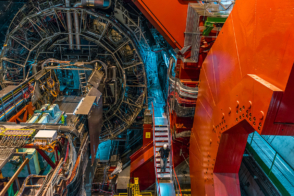A report from the ALICE experiment.

One of the fundamental questions in quantum chromodynamics is how hadrons are produced in high-energy collisions. More specifically: what determines the relative production rates of baryons, which contain three valence quarks, and mesons, which consist of a quark and an antiquark?
In electron–positron, electron–proton and proton–proton collisions, where a small number of particles is produced, the hadronisation process is expected to be universal: it does not depend on the type of colliding particles, but only on the parent quark or gluon. It has been found, however, that in proton–proton and proton–lead collisions at LHC energies, the baryon-to-meson ratios p/π, Λ/KS0 and Λc/D0 are significantly larger than in e+e– and ep collisions. This enhancement, at intermediate transverse momentum pT (1–5 GeV), in small systems is qualitatively similar to that observed in heavy-ion collisions, e.g. between lead ions. However, in heavy-ion collisions this behaviour has been related to the interplay between hadronisation and the creation and expansion of a hot and dense quark–gluon plasma (QGP) via so-called quark recombination involving partons from within the QGP.
To shed light on hadron-production mechanisms in collisions at the LHC, ALICE has performed a novel study of the production of strange and multi-strange hadrons inside and outside energetic jets in proton–proton and proton–lead collisions. The method separates particles produced in association with a hard scattering process (within jets) from those produced in soft processes with low momentum transfer that dominate the underlying event.
The results show that the strange baryon-to-meson Λ/KS0 ratio enhancement seen in the inclusive measurement is absent within the jet cone and restricted to soft-particle production processes outside the jet cone (figure 1, left). On the other hand, the multi- strange to single-strange hyperon yield ratio Ω±/Λ (figure 1, right) shows a similar pT dependence in the interval 2 < pT < 5 GeV inside and outside the jet cone, while different behaviour is observed for the Ξ±/Λ ratio (not shown). This suggests that the baryon production mechanism also depends on the strangeness content of the baryons; the production of hyperons in jets becomes similar to that in the underlying event for baryons with large strangeness content.
These measurements will help to improve the modelling of particle production at the LHC
These measurements provide new input to understand the relative contribution of soft and hard processes to multi-strange hadron production, and thus will help to improve the modelling of particle production at the LHC. To illustrate how, two calculations with different hadronisation models are shown in the figure: one model includes string formation beyond leading colour (CR-BLC, blue band), while the other includes colour ropes (red dashed line). While one of the models describes the Λ/KS0 ratio inside jets, the other shows a better agreement with the Ω±/Λ ratio.
ALICE has also investigated the multiplicity dependence of strange baryon-to-meson and baryon-to-baryon ratios in jets in proton–lead collisions and compared it with those in proton–proton collisions. Within the current experimental precision, no difference between the two collision systems, nor a dependence on the event multiplicity, is observed. These studies will further benefit from the increased precision that will be achieved with the substantially larger data samples from ongoing LHC runs.
Further reading
ALICE Collab. 2022 arXiv:2211.08936.





